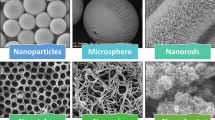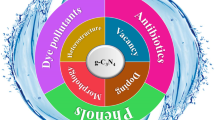Abstract
Visible-light response C, N-codoped TiO2 nanotubes with high aspect ratios were prepared by a two-step method. First the TiO2 nanotubes were synthesized by an ion-exchange method, and then the nanotubes were calcined at different temperatures with melamine as nitrogen and carbon source. X-ray diffraction (XRD), X-ray photoelectron spectroscopy (XPS), UV-vis diffusive reflectance spectroscopy (DRS), scanning electron microscopy (SEM), and N2 adsorption-desorption isotherms were employed to characterize the as-prepared samples. The results show that the nanotubular structure is destroyed when the calcination temperature is higher than 823 K. Further increase the temperature to 923 K, TiO2 is reduced to TiO. The photocatalytic activity of the codoped TiO2 nanotubes/nanorods was evaluated by degradation of Rhodamine B under visible-light irradiation (> 420 nm). Compared with N doped P25, these codoped TiO2 nanotubes/nanorods possess a superior photocatalytic acticity, owing to the synergistic effects of the nitrogen and carbon co-doping.
Similar content being viewed by others
References
Li H.X., Bian Z.F., Zhu J., Zhang D.Q., Li G.S., Huo Y.N., Li H., and Lu Y.F., Mesoporous titania spheres with tunable chamber stucture and enhanced photocatalytic activity, J. Am. Chem. Soc., 2007, 129: 8406.
Zheng Z.K., Huang B.B., Qin X.Y., Zhang X.Y., Dai Y., Jiang M.H., Wang P., and Whangbo M.H., Highly efficient photocatalyst: TiO2 microspheres produced from TiO2 nanosheets with a high percentage of reactive {001} facets, Chem. Eur. J. 2009, 15: 12576.
Wang X.N., Huang B.B., Wang Z.Y., Qin X.Y., Zhang X.Y., Dai Y., and Whangbo M.H., Synthesis of anatase TiO2 tubular structures microcrystallites with a high percentage of {001} facets by a simple one-step hydrothermal template process, Chem. Eur. J., 2010 16: 7106.
Lan Y., Gao X.P., Zhu H.Y., Zheng Z.F., Yan T.Y., Wu F., Ringer S.P., and Song D.Y., Titanate nanotubes and nanorods prepared from rutile powder, Adv. Funct. Mater., 2005, 15: 1310.
Kobayashi S., Hanabusa K., Hamasaki N., Kimura M., and Shirai H., Preparation of TiO2 hollow-fibers using supramolecular assemblies, Chem. Mater. 2000, 12: 1523.
Nelson K., and Deng Y.L., Enhanced light scattering from hollow polycrystalline TiO2 particles in a cellulose matrix, Langmuir, 2008, 24: 975.
Dvoranová D, Brezová V, Mazúr M, and Malati M.A., Investigations of metal-doped titanium dioxide photocatalysts, Appl. Catal. B, 2002, 37: 91.
Litter M.I., Heterogeneous photocatalysis: Transition metal ions in photocatalytic systems, Appl. Catal. B: Environ, 1999, 23: 89.
Herrmann J.-M., Tahiri H., Guillar C., and Pichat P., Photocatalytic degradation of aqueous hydroxy-butandioic acid (malic acid) in contact with powdered and supported titania in water, Catal. Today, 1999, 54: 131.
Asahi R., Ohkawa T., Aoki K., and Taga Y., Visible-light photocatalysis in nitrogen-doped titanium oxides, Science, 2001, 293: 269.
Yamaki T., Sumita T., and Yamamoto S., Formation of TiO2-xFx compounds in fluorine-implanted TiO2, J. Mater. Sci. Lett., 2002, 21: 33.
Zhao W., Ma W.H., Chen C.C., Zhao J.C., and Shuai Z.G., Efficient degradation of toxic organic pollutants with Ni2O3/TiO2−x Bx under Visible Irradiation, J. Am. Chem. Soc., 2004, 126: 4782.
Irie H., Watanabe Y., and Hashimoto K., Carbon-doped anatase TiO2 powders as a visible-light sensitive photocatalyst, Chem. Lett., 2003, 32: 772.
Xie Y., Li Y.Z., and Zhao X.J., Low-temperature preparation and visible-light-induced catalytic activity of anatase F-N-codoped TiO2, J Mol. Catal. A Chem., 2007, 277: 119.
Chen D.M., Jiang Z.Y., Geng J.Q., Wang Q., and Yang D., Carbon and nitrogen co-doped TiO2 with enhanced visible-light photocatalytic activity, Ind. Eng. Chem. Res., 2007, 46: 2741.
Ohno T., Tsubota T., Toyofuku M., and Inaba R., Photocatalytic activity of a TiO2 photocatalyst doped with C4+ and S4+ ions having a rutile phase under visible light, Catal. Lett., 2004, 98: 255.
Sakthivel S., and Kisch H., Daylight photocatalysis by carbon-modified titanium dioxide, Angew. Chem., Int. Ed., 2003, 42: 4908.
Diwald O., Thompson T.L., Zubkov T., Goralski E.G., Walck S.D., and Yates J.T., Jr. Photochemical activity of nitrogen-doped rutile TiO2 (110) in visible light, J. Phys. Chem. B, 2004, 108: 6004.
Author information
Authors and Affiliations
Corresponding author
Rights and permissions
About this article
Cite this article
Wang, J., Huang, B., Wang, Z. et al. Synthesis and characterization of C, N-codoped TiO2 nanotubes/nanorods with visible-light activity. Rare Metals 30 (Suppl 1), 161–165 (2011). https://doi.org/10.1007/s12598-011-0261-1
Received:
Revised:
Accepted:
Published:
Issue Date:
DOI: https://doi.org/10.1007/s12598-011-0261-1




